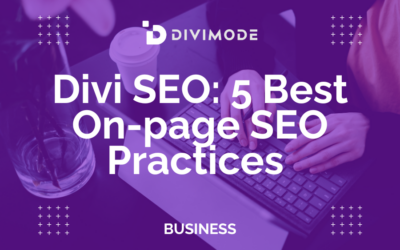Out-of-the-box and with the right theme, WordPress offers an amazing baseline for your SEO strategy. However, regardless of how powerful and flexible the CMS is, there are common WordPress SEO mistakes to avoid at all costs, if you want to stand a chance against your competitors on Google.
Namely, according to Ahrefs, the best-ranked pages get the most traffic 49% of the time, and only 5.7% of the pages rank in the top 10 search results within a year. Furthermore, as per Backlinko, less than 1% of users click on the second results page, which is not where you want to be if you run your business online.
The good news is that all SEO mistakes can be avoided, as long as you are aware that you’re making them, and you know how to avoid them in the first place. Without further ado, let’s cover the common WordPress SEO mistakes to avoid when optimizing for search engine conversions. Let’s begin.
Table of Contents
Common WordPress SEO Mistakes
1. Ignoring SEO-Friendly Permalink Structures
By default, WordPress sets your permalink structure to a format that is not very SEO-friendly.
It often includes dates and numbers that don’t communicate useful information to search engines.
To optimize your site, switch to a ‘Post name’ permalink structure, which includes the title of your post. This change can make a significant difference in your SEO efforts.
2. Overlooking the Importance of Sitemaps
A sitemap is crucial for SEO as it helps search engines crawl and index your site more effectively.
While some SEO plugins automatically generate sitemaps, it’s important to ensure that your sitemap is updated and submitted to search engines like Google via their respective Webmaster Tools.
Solution:
- Install an SEO plugin like Yoast SEO or Google XML Sitemaps.
- Automatically generate a sitemap through the plugin.
- Submit your sitemap to search engines via Google Search Console and Bing Webmaster Tools.
3. Not Optimizing for Mobile
With the increasing use of mobile devices for web browsing, having a mobile-friendly website is no longer optional.
Google’s mobile-first indexing means your site’s mobile version will impact your search engine ranking.
Ensure your WordPress theme is responsive and test your site on various devices to ensure compatibility.
4. Failing to Use SEO Plugins
WordPress offers a variety of SEO plugins like Yoast SEO, All in One SEO Pack, and others that can significantly aid in optimizing your website.
These plugins offer guidance on how to improve your content and settings to make your site more search engine friendly. Neglecting these tools can leave you at a severe disadvantage.
5. Not Focusing on Page Loading Speed
Slow-loading websites can lead to a high bounce rate and poor user experience, negatively impacting your SEO. Ensure your WordPress site is optimized for speed by using caching plugins, optimizing images, and choosing a reliable hosting provider.
Solution:
- Use speed testing tools like Google PageSpeed Insights to identify issues.
- Optimize images with tools like Smush or ShortPixel.
- Install a caching plugin like W3 Total Cache or WP Super Cache.
- Choose a reliable and fast hosting provider.
Common General SEO Mistakes
1. Working With the Wrong Keywords
Keywords are essential to your SEO strategy. However, there are lots of keywords to aim for, and not finding the most effective ones can result in detrimental results for your pages.
If nobody is researching the topics that you’ve chosen with your keywords, you can’t expect to get traffic. In fact, according to Ahrefs, over 96% of content doesn’t get traffic from Google, so, if you pick the right keywords, you’re at the right place.
So, how can you avoid this SEO mistake? Well, the process is pretty straightforward, and it consists of knowing your industry thoroughly, and having an understanding of how keyword research works.
The ‘seed’ keywords are the beginning of your SEO strategy. They are synonymous for your niche or your business. For example, if you’re selling tea on your website, the seed keywords would appear as the following:
- tea
- tea type
- tea pot
- herbal tea
- etc
When you have the broad ideas of your target market at hand, you can get into the specifics of finding the right keywords for your SEO strategy.
Looking at the keywords that competitors aim for is the best way to speed up your keyword research process. For example, for the tea industry, you may find actual competitors when searching ‘tea stores’ or ‘tea stores near me’ rather than only tea.

Once you locate the competitor that matches with your target audience and products you sell, you need to check which are the top ranked pages from which that website gets the most traffic from.
After going from competitor to competitor, you will start forming the list of keywords that you need to optimize your content for, for instance:
- shop tea
- tea ware
- online tea shop
- tea gift box
- etc
Make sure to use keyword research tools, as well as Google’s Keyword Planner in order to get all the relevant keywords that you’ll need.
2. Missing The Search Intent
Aligning your pages and keywords with search intent is crucial for ranking high on Google. This concept goes beyond mere keyword matching; it delves into the core reason behind a user’s search query.
Take the query “best herbal tea” as an instance. A cursory glance at Google reveals a predominance of blog posts over e-commerce links.

This pattern isn’t random; it reflects Google’s understanding that users are more inclined to research and compare options rather than make an immediate purchase.
Consequently, an eCommerce website focusing solely on sales without offering comparative insights might find itself lower in the rankings.
Thus, to navigate this SEO challenge, one must delve into the three Cs:
- Content type
- Content format
- Content angle.
A vital addition to the three Cs is understanding the user’s stage in the buying cycle. Are they in the initial awareness stage, seeking information and options?
Or are they further along, ready to make a purchase? Tailoring content to these stages, from informative blog posts to detailed product reviews, can enhance relevance and engagement.
Moreover, incorporating user feedback and questions into your content can significantly enhance its value. Engaging with user comments, addressing common queries in your content, and even updating older posts with new information or user-generated tips can create a more dynamic and user-focused experience.
This approach not only aligns with search intent but also builds trust and authority, which are essential factors in SEO.
3. Lack of Right Backlinks
Backlinks stand as a pivotal factor in determining a page’s rank on Google. Thus, if your page isn’t ranking as high as desired, a lack of sufficient backlinks might be one of the culprits.
To address this shortfall, one effective method is to actively reach out to potential linkers who might find your content valuable and relevant. However, the key addition to this strategy should be a focus on building relationships and providing value.

Instead of cold outreach, consider engaging with potential linkers through social media, commenting on their posts, or even collaborating on content.
This not only increases the chances of gaining a backlink but also fosters a network of mutual support within the SEO community.
Furthermore, regularly updating your content and keeping it relevant and informative can naturally attract backlinks.
Engaging with your audience, soliciting feedback, and incorporating user-generated content or suggestions can enhance the value of your content, making it more link-worthy.
4. Not Utilizing Internal Linking
Internal linking is a facet that often goes unnoticed yet plays a critical role in enhancing a website’s performance. Internal links not only help Google in discovering new content but also facilitate the flow of PageRank throughout your site.
Despite these significant benefits, internal links frequently remain an underutilized element in many SEO strategies, which is a glaring oversight, and can be attributed to the perceived difficulty in implementing them effectively.

However, there are streamlined approaches to integrate internal linking into your SEO practices effectively, such as identifying internal link opportunities.
Beyond just identifying opportunities, there’s a broader strategy that needs to be employed. One key aspect often overlooked is the strategic placement and relevance of these links.
Instead of randomly adding internal links, they should be strategically placed where they can add real value to the reader’s journey, guiding them through related topics and deepening their engagement with your site.
Additionally, regularly reviewing and updating your internal linking structure is vital. As new content is added or old content becomes outdated, the internal link structure should evolve to reflect these changes.
This not only helps in maintaining a coherent and user-friendly site architecture but also ensures that the distribution of PageRank within your site remains optimal.
5. Forgetting That It’s a Process

In the world of SEO, it’s crucial to recognize that SEO is not a one-time task, but an ongoing process. The common misconception of treating SEO as a set-and-forget practice can lead to missed opportunities and a decline in rankings.
It’s important to understand that maintaining a top position on search engines is a continual competition; your competitors are consistently investing resources to surpass you.
To avoid this critical mistake, it’s imperative to develop and implement a consistent, evolving SEO strategy. This strategy doesn’t have to be overly complex; it needs to be practical, repeatable, and adaptable to changes in search algorithms and market trends.
One such approach is what’s known as the “Orchard Strategy,” which simplifies the process into three key steps:
- Planting trees (creating pages)
- Picking low-hanging fruits (achieving first-page keyword rankings)
- Squeezing more juice out of them (optimizing existing content)
This strategy emphasizes the importance of continual growth and optimization in SEO.
Therefore, regularly analyzing your SEO performance, understanding evolving user behaviors, and keeping up with Google’s algorithm updates are critical. This involves not just looking at your site but also monitoring competitors’ strategies and adjusting your approach accordingly.
Furthermore, engaging with your audience to understand their needs and feedback can provide invaluable insights for your SEO strategy. This might include leveraging social media, surveys, or user comments to refine your content and ensure it aligns with user intent and expectations.
In essence, the key to long-term success lies in continuous learning, adapting, and engaging with both your audience and the broader SEO landscape. This proactive approach will help maintain and improve your search engine rankings over time.
Wrapping Up
In conclusion, treat your WordPress site as an investment in your digital presence. Nurture it with the best SEO practices, and it will undoubtedly return the favor in the form of increased traffic, better user engagement, and, ultimately, the realization of your online goals.
The journey to SEO mastery may be continuous, but with diligence, patience, and the right strategies, it is a journey that promises great rewards.

Try Divi Areas Pro today
Sounds interesting? Learn more about Divi Areas Pro and download your copy now!
Many pre-designed layouts. Automated triggers. No coding.
Click here for more details






